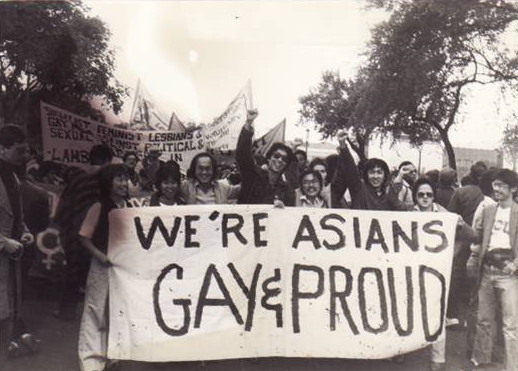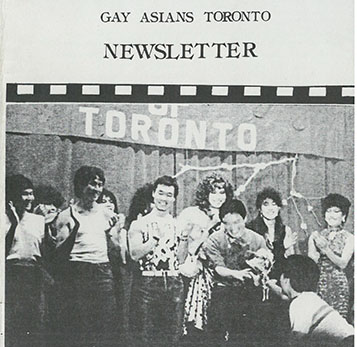 Many community groups and organizations have played important roles in the birth, development and growth of modern LGBT culture. For many LGBT people, groups have been our introduction to queer communities, the places where we made friends, developed our sense of belonging, and organized around important issues. In many Canadian cities, “gay liberation” organizations were founded in the early 1970s, becoming the nexus for political, social and cultural activities — and as the LGBT communities expanded and evolved, those united groups gave way to expanded networks of groups serving more specialized needs. Yet their importance is frequently overlooked: many such groups have garnered little media coverage, leaving their roles in queer history not well-understood by later generations of LGBT people. The Canadian Lesbian and Gay Archives maintains vertical files of historical documents from many community groups from Toronto and nationwide, and even some from other countries. Here, we will briefly highlight Gay Asians of Toronto, a group which had an important role in establishing a place in the community for LGBT people of colour whose unique issues and perspectives were too often marginalized.
Many community groups and organizations have played important roles in the birth, development and growth of modern LGBT culture. For many LGBT people, groups have been our introduction to queer communities, the places where we made friends, developed our sense of belonging, and organized around important issues. In many Canadian cities, “gay liberation” organizations were founded in the early 1970s, becoming the nexus for political, social and cultural activities — and as the LGBT communities expanded and evolved, those united groups gave way to expanded networks of groups serving more specialized needs. Yet their importance is frequently overlooked: many such groups have garnered little media coverage, leaving their roles in queer history not well-understood by later generations of LGBT people. The Canadian Lesbian and Gay Archives maintains vertical files of historical documents from many community groups from Toronto and nationwide, and even some from other countries. Here, we will briefly highlight Gay Asians of Toronto, a group which had an important role in establishing a place in the community for LGBT people of colour whose unique issues and perspectives were too often marginalized.  Gay Asians of Toronto was an organization encouraging political advocacy and social support for gay Asian individuals living in Toronto. Formed in 1980, the organization strived to provide a nurturing environment where gay Asians could find support through shared personal experiences and exchange of information. The group lasted from the 1980s to the early 2000s. The group had its genesis after artist Richard Fung attended the 1979 National March on Washington for Lesbian and Gay Rights, inspiring him to launch an organization that would create a sense of inclusivity and belonging for the Asian Canadians in Toronto. When Fung got back from the conference, he contacted Gerald Chan, an activist who had published “Out of the Shadows”, an article on being gay and Chinese, in the Toronto-based magazine Asianadian. They were soon joined by Nito Marquez, Tony Souza and Tony Chung. After posting ads around Toronto, the organization began meeting at the 519 Church Street community centre as a peer discussion group every other Saturday. As an organization, GAT aimed to promote unity and mutual support among gay Asians by organizing social, cultural and educational activities for their members. In addition, the organization wanted to provide culturally sensitive social and support services, as well as to advocate on issues relevant to their community’s concerns. GAT’s main political goal was to create a collective gay Asian community as a source of empowerment. In 1982, Gay Asians of Toronto were chosen to lead Toronto’s Pride parade. The Toronto Pride Committee approached GAT to lead the parade after wanting to host the event in Grange Park; because of its proximity to Chinatown, there was much disapproval among the Chinese Canadian community. Alan Li, a prominent group member, was the host speaker, and explained in his speech that “as an Asian I have additional battle in the fight for my own liberation and for the liberation of the Asian community. As gays, we have to fight for our rights in the straight society, but Asian gays, like black gays, Jewish gays, sexual minorities, and the handicapped among us and every other minority within the minority have other battles to face as well.” In 1983, Gay Asians of Toronto launched the quarterly magazine Celebrasian. By 1990, 18 issues had been released. Celebrasian served as a forum for organizational communication, and was provided in English and Chinese translations. The magazine usually consisted of local and international community news, personal stories, poems, interviews of Asian-Canadians and ads seeking for partners.
Gay Asians of Toronto was an organization encouraging political advocacy and social support for gay Asian individuals living in Toronto. Formed in 1980, the organization strived to provide a nurturing environment where gay Asians could find support through shared personal experiences and exchange of information. The group lasted from the 1980s to the early 2000s. The group had its genesis after artist Richard Fung attended the 1979 National March on Washington for Lesbian and Gay Rights, inspiring him to launch an organization that would create a sense of inclusivity and belonging for the Asian Canadians in Toronto. When Fung got back from the conference, he contacted Gerald Chan, an activist who had published “Out of the Shadows”, an article on being gay and Chinese, in the Toronto-based magazine Asianadian. They were soon joined by Nito Marquez, Tony Souza and Tony Chung. After posting ads around Toronto, the organization began meeting at the 519 Church Street community centre as a peer discussion group every other Saturday. As an organization, GAT aimed to promote unity and mutual support among gay Asians by organizing social, cultural and educational activities for their members. In addition, the organization wanted to provide culturally sensitive social and support services, as well as to advocate on issues relevant to their community’s concerns. GAT’s main political goal was to create a collective gay Asian community as a source of empowerment. In 1982, Gay Asians of Toronto were chosen to lead Toronto’s Pride parade. The Toronto Pride Committee approached GAT to lead the parade after wanting to host the event in Grange Park; because of its proximity to Chinatown, there was much disapproval among the Chinese Canadian community. Alan Li, a prominent group member, was the host speaker, and explained in his speech that “as an Asian I have additional battle in the fight for my own liberation and for the liberation of the Asian community. As gays, we have to fight for our rights in the straight society, but Asian gays, like black gays, Jewish gays, sexual minorities, and the handicapped among us and every other minority within the minority have other battles to face as well.” In 1983, Gay Asians of Toronto launched the quarterly magazine Celebrasian. By 1990, 18 issues had been released. Celebrasian served as a forum for organizational communication, and was provided in English and Chinese translations. The magazine usually consisted of local and international community news, personal stories, poems, interviews of Asian-Canadians and ads seeking for partners. In 1985, Gay Asians of Toronto hosted the Seventh International Gay Association Conference, with the theme of “Smashing Borders and Opening Spaces: General Oppression of Gay and Lesbian People”. The conference was attended by at least 500 delegates from different countries. Most of the discussion revolved around political organization, and confronting cultural identity and the racial politics of the gay community. In 1986, Fung produced the video Orientations, a documentary film in which 14 gay and lesbian Asians telling their personal stories about coming out and finding their place in the community. In 1990, Gay Asians of Toronto established an AIDS service organization to deal with the unique needs of LGBT Asians. The group provided support and education around AIDS, and addressed the homophobia gay Asians may experience. On World AIDS Day in December 1994, the organization’s AIDS project merged with Southeast Asian Service Centre’s Vietnamese AIDS project and the Toronto Chinese Health Education to form a new alliance organization called Asian Community AIDS Services. The group dissolved in the 2000s. ————————- Original written by Jana Borras with Sam Maalouf for Prof. Elspeth Brown’s seminar on Queer Theory in the Fall of 2015 at the University of Toronto at Mississauga. The original was designed for wikipedia. This version edited by The ArQuives volunteer Craig Schiller for The ArQuives Blog Putting the intersection of Asian identity and sexuality on the map from the 1970s to 2000s
In 1985, Gay Asians of Toronto hosted the Seventh International Gay Association Conference, with the theme of “Smashing Borders and Opening Spaces: General Oppression of Gay and Lesbian People”. The conference was attended by at least 500 delegates from different countries. Most of the discussion revolved around political organization, and confronting cultural identity and the racial politics of the gay community. In 1986, Fung produced the video Orientations, a documentary film in which 14 gay and lesbian Asians telling their personal stories about coming out and finding their place in the community. In 1990, Gay Asians of Toronto established an AIDS service organization to deal with the unique needs of LGBT Asians. The group provided support and education around AIDS, and addressed the homophobia gay Asians may experience. On World AIDS Day in December 1994, the organization’s AIDS project merged with Southeast Asian Service Centre’s Vietnamese AIDS project and the Toronto Chinese Health Education to form a new alliance organization called Asian Community AIDS Services. The group dissolved in the 2000s. ————————- Original written by Jana Borras with Sam Maalouf for Prof. Elspeth Brown’s seminar on Queer Theory in the Fall of 2015 at the University of Toronto at Mississauga. The original was designed for wikipedia. This version edited by The ArQuives volunteer Craig Schiller for The ArQuives Blog Putting the intersection of Asian identity and sexuality on the map from the 1970s to 2000s
